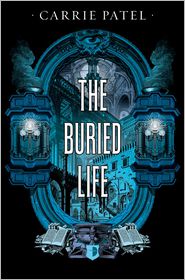Go Underground with The Buried Life
 There’s a lot to unpack in The Buried Life, the debut novel from Carrie Patel that weaves action, mystery, science fiction, and fantasy around a kernel of social awareness, resulting in an absorbing, fast-paced read that nonetheless forces the reader to reflect upon their own surroundings.
There’s a lot to unpack in The Buried Life, the debut novel from Carrie Patel that weaves action, mystery, science fiction, and fantasy around a kernel of social awareness, resulting in an absorbing, fast-paced read that nonetheless forces the reader to reflect upon their own surroundings.
The Buried Life: Recoletta Book 1
The Buried Life: Recoletta Book 1
By Carrie Patel
In Stock Online
Paperback $7.99
The book is set in an underground city some ways into a dystopian future, but it bears little resemblance to most dystopian stories because the event that triggered it happened in the past—likely sometime in the Victorian period. It’s an intriguing blend of past and future, a world where there are still laundresses and frock coats, but women’s rights have evolved and archeological digs unearth buildings that are still standing in our own present-day.
The action begins with the murder of an important historian (I suspect that the historians in the audience will smile at the political importance of their profession in this world, where they’d never have to worry about applying for grants.) Inspector Liesl Malone is on the case, saddled with a rookie partner and largely blocked by a powerful, oligarchic government. This book is unusual in that it’s led by two heroines, their stories presented in largely independent sections of the book, and we meet our second one in a pickle: she’s a laundress to the rich and powerful, and she’s lost a pearl button (fortunately, a second murder solves this particular problem). Naturally, she too is soon swept up into a conspiracy that goes far beyond a string of murders…
Basing the story around two heroines who really only interact in a handful of scenes is an unusual, gutsy choice. Jane, the laundress, particularly shines; she’s brave and funny without being implausibly skilled or brilliant, and she’s easy to root for. Inspector Malone is a little harder to warm to, partly because her motivations remain shrouded, and partly because she’s prickly and standoffish, but the book deserves major props for creating two very interesting female characters who drive significant portions of the action. The supporting cast members are also particularly enjoyable, to the extent that they occasionally upstage the leads. Malone’s rookie partner is a delight—a fizzing, scene-stealing character who steals every single scene he’s in—and Jane’s friend Fredrick, a nosey reporter, is cast from a similar mold.
Patel’s worldbuilding is fascinating, and left me wanting much, much more. At the top of her social order sit the whitenails, stuffy aristocrats with a proclivity for growing their fingernails out six inches, for whom going on a pleasant walk in the wilderness constitutes social suicide. There’s a Council-based government, and a creaky and extensive bureaucracy, and extreme censorship, and neighborhoods built into cliff faces—basically just a huge amount of fascinating detail.
Patel’s style reminded me of a very different writer: Richelle Mead, author of the Vampire Academy series and the Age of X, who uses a very similar learn-as-you-go style of worldibuilding style. The Buried Life is what happens when you cross the socio-political bent of The Hunger Games with that kind of ground-up scene setting, mix in a murder mystery à la Castle, and top it off with a soupçon of Victoriana.
Fans of steampunk alternate histories will enjoy this book, and I suspect that readers of the lighter end of the dystopian genre will too. It’s quick, filled with enjoyable characters, and contains enough socio-political reflectiveness to give you something to chew on. It’s a great debut effort, and, even better, the first in a series.
Oh, one more thing: the cover’s gorgeous.
The book is set in an underground city some ways into a dystopian future, but it bears little resemblance to most dystopian stories because the event that triggered it happened in the past—likely sometime in the Victorian period. It’s an intriguing blend of past and future, a world where there are still laundresses and frock coats, but women’s rights have evolved and archeological digs unearth buildings that are still standing in our own present-day.
The action begins with the murder of an important historian (I suspect that the historians in the audience will smile at the political importance of their profession in this world, where they’d never have to worry about applying for grants.) Inspector Liesl Malone is on the case, saddled with a rookie partner and largely blocked by a powerful, oligarchic government. This book is unusual in that it’s led by two heroines, their stories presented in largely independent sections of the book, and we meet our second one in a pickle: she’s a laundress to the rich and powerful, and she’s lost a pearl button (fortunately, a second murder solves this particular problem). Naturally, she too is soon swept up into a conspiracy that goes far beyond a string of murders…
Basing the story around two heroines who really only interact in a handful of scenes is an unusual, gutsy choice. Jane, the laundress, particularly shines; she’s brave and funny without being implausibly skilled or brilliant, and she’s easy to root for. Inspector Malone is a little harder to warm to, partly because her motivations remain shrouded, and partly because she’s prickly and standoffish, but the book deserves major props for creating two very interesting female characters who drive significant portions of the action. The supporting cast members are also particularly enjoyable, to the extent that they occasionally upstage the leads. Malone’s rookie partner is a delight—a fizzing, scene-stealing character who steals every single scene he’s in—and Jane’s friend Fredrick, a nosey reporter, is cast from a similar mold.
Patel’s worldbuilding is fascinating, and left me wanting much, much more. At the top of her social order sit the whitenails, stuffy aristocrats with a proclivity for growing their fingernails out six inches, for whom going on a pleasant walk in the wilderness constitutes social suicide. There’s a Council-based government, and a creaky and extensive bureaucracy, and extreme censorship, and neighborhoods built into cliff faces—basically just a huge amount of fascinating detail.
Patel’s style reminded me of a very different writer: Richelle Mead, author of the Vampire Academy series and the Age of X, who uses a very similar learn-as-you-go style of worldibuilding style. The Buried Life is what happens when you cross the socio-political bent of The Hunger Games with that kind of ground-up scene setting, mix in a murder mystery à la Castle, and top it off with a soupçon of Victoriana.
Fans of steampunk alternate histories will enjoy this book, and I suspect that readers of the lighter end of the dystopian genre will too. It’s quick, filled with enjoyable characters, and contains enough socio-political reflectiveness to give you something to chew on. It’s a great debut effort, and, even better, the first in a series.
Oh, one more thing: the cover’s gorgeous.
